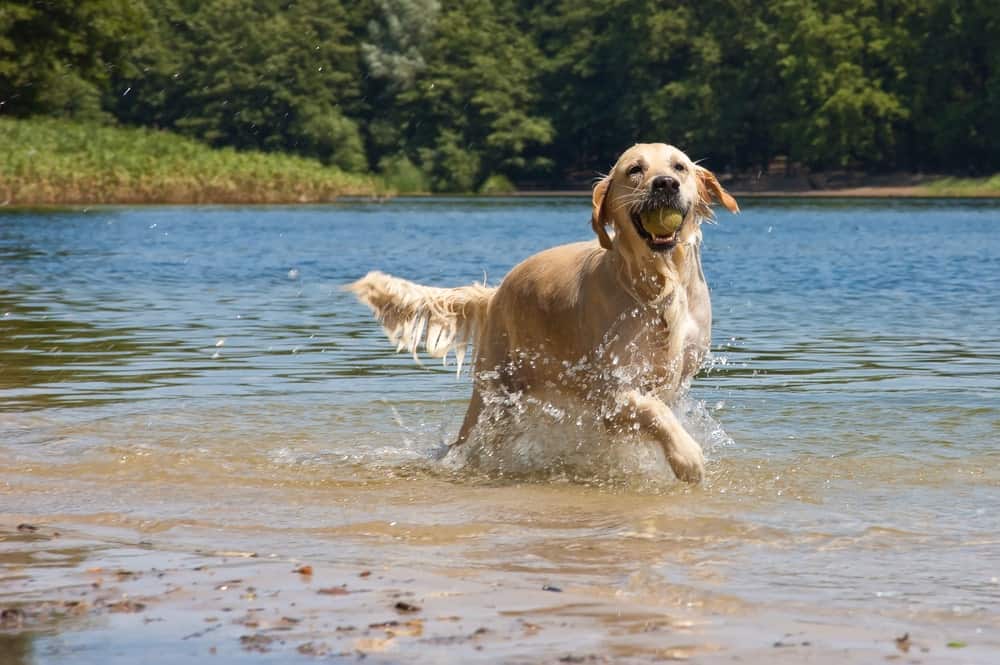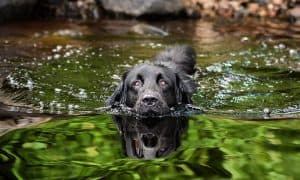“This post contains affiliate links, and I will be compensated if you make a purchase after clicking on my links.”
Since the influx of tragic deaths of dogs across the country after exposure to blue-green algae, reports now confirm the deadly bacteria has been found in at least 17 states with the potential to be even more widespread.

Blue-green algae is a term used to describe cyanobacteria, a bacterial organism that isn’t visible to the naked eye until several of the organisms clump together, giving the appearance of algae. The Pet Poison Helpline explains,:
Cyanobacteria (also known as blue-green algae) are microscopic bacteria found in freshwater lakes, streams, ponds and brackish water ecosystems. They can produce toxins (such as microcystins and anatoxins) that affect people, livestock and pets that swim in and drink from the algae-contaminated water… Algal concentrations vary throughout the year, but are most abundant during periods of hot weather in mid- to late-summer months and are most likely to be found in nutrient-rich water. While most blue-green algae blooms do not produce toxins, it is not possible to determine the presence of toxins without testing. Thus, all blooms should be considered potentially toxic. Very small exposures, such a few mouthfuls of algae-contaminated water, may result in fatal poisoning.
The first reports of cyanobateria-related deaths came last July when three dogs who had all visited a popular Austin, Texas lake-front dog park died within hours of visiting the park. City officials tested the lake waters and determined that about 40% of the lake surface was covered in blue-green algae.
Next, a Minnesota dog owner took her dog for a swim at the Foster-Arend Pond in Rochester. The city issued a warning urging pet owners to check water conditions before allowing their dogs to play in or near any lakes or slow-flowing streams.
A dog owner in Oregon reported that her dog died shortly after swimming in the Willametter River at the Keizer Rapids Dog Park in Keizer in July.
Two dogs, an adult dog and a young puppy, died after drinking from a private pond in a Vermont backyard last month.
On July 31, Tamra Massey let her dog swim in Guadalupe River, just steps from her own Austin, Texas backyard, as she’d always done. Within 5 minutes from exiting the water, the 3-year old dog began having seizures. She did not survive the 15-minute drive to the veterinarian.
On August 9, three dogs died within hours of playing at a Wilmington, North Carolina pond. While one dog swam, the other two only played in the mud at the pond’s edge. The dogs’ owner said the water was crystal clear the day her dogs played at the pond. You would never have known that a deadly toxin was present.
Just one day later, on August 10, a couple took their young dog for a swim in Lake Allatoona in Marietta, Georgia. About a half hour after leaving the lake, they rushed their dog to the vet. She did not survive the drive.
On August 14, officials in Edmond, Oklahoma temporarily closed down the Edmond Dog Park pond after Oklahoma Department of Wildlife Conservation staff inspected the pond and found a small amount of blue-green algae in the water. The pond closure was a proactive response to nationwide concerns. No dog owners had reported illnesses or deaths after playing in the pond.
Last week, blue-green algae blooms were confirmed in a third reservoir in Idaho, prompting officials to release a public advisory. The latest findings at Magic Valley Reservoir follow ongoing advisories at Salmon Falls and Mormon Creek reservoirs, which tested positive for cyanobacteria in July.
In addition to the cases above, blue-green algae has been confirmed in Ohio, Maryland, Massachusetts, New Jersey, New York, South Carolina, Rhode Island, California, Florida, and Minnesota. Unconfirmed cases have also been reported as far north as Maine. It’s not just possible, but probable, that the deadly bacteria is present in your state, too.
Blue-green algae can grow in lakes, oceans, ponds, streams and rivers. It can bloom in a pool of stagnant water or in your dog’s outdoor water bowls, so always keep them clean and filled with fresh water, especially during summer when temperatures are prime for bacterial growth.
Symptoms of exposure include vomiting, diarrhea, seizures, weakness, collapse/unconsciousness, disorientation, excessive drooling, breathing difficulties, partial paralysis, and death.
If you experience these, or ANY unusual symptoms after swimming, playing, or walking near a body of water with your dog, visit your veterinarian immediately.



















Joyce
Aug 15, 2019 at 3:37 pm
Add Idaho to the list as well.
Note not all bodies of water are monitored due to lack of funds and personnel.
DEQ’s Surface Water > Recreation Health Advisories
Vick
Aug 14, 2019 at 8:03 pm
You cant give a list?
Brandy Arnold
Aug 15, 2019 at 10:43 am
They’re all in the article…Texas, North Carolina, Georgia, Minnesota, Ohio, Maryland, Massachusetts, New Jersey, New York, South Carolina, Rhode Island, Vermont, California, Florida, Oregon
Samm
Aug 15, 2019 at 5:57 pm
Did you even read the article?